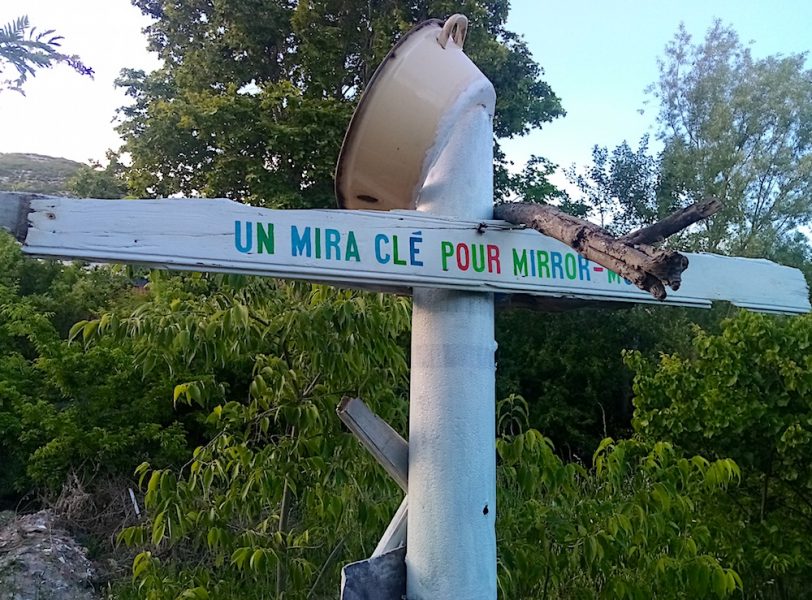The Miracle of Miramar – Charlie Fox (Mai 2021)
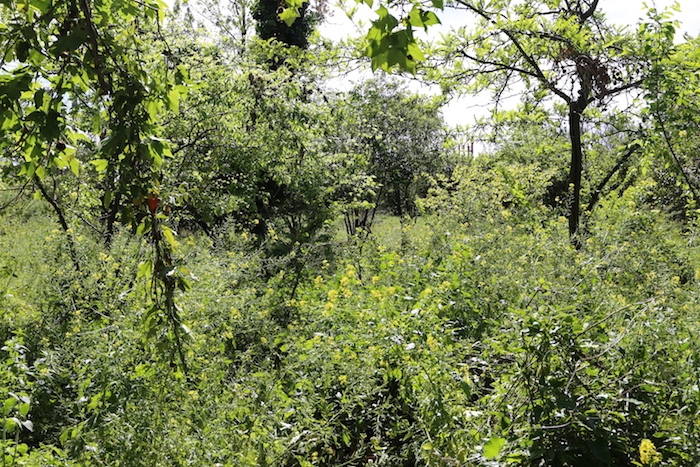
A Mirage (25 October 2020):
I first visited Miramar in October 2020, at the beginning of another confinement in France. The ground was dry but you could still tell this was a special place as new growth from wild fennel and an array of assorted grasses, grew up through the desiccated summer undergrowth and leaf litter. The site despite its unpromising location, by the railway and overlooked by a container storage facility, immediately seemed to encapsulate a space between an abandoned botanical garden and place of unkempt beauty. It presented something of a mirage – as stumbling up a steep crumbling verge, covered in bramble and coarse vegetation – I emerge into the sun; a meadow dried out, gently appears, from the broken ground that at first focus materializes as a scrubby dumping ground.
However, the earth and the layers of humus beneath, built up in the Villa Gardens reflect the natural geological erosion and decomposition that makes up the long history of the terre of the Marseille Basin. It is a very special bay, with its long north south axis, framed at its back by the protective curve of mountains and on either end sealed off by natural cliffs. It is a beautiful site precisely because the city sits in a landscape of diverse beauty – with sea, mountain, and geology providing inestimable ingredients for the rich interplay of terrain and life. But much of this extraordinary nature-city interface has been disturbed or covered over with concrete and the debris of a rapidly changing, unregulated industry. A feeble attempt to reproduce the natural fertility and create a kitsch Provencal nature can be seen in the potted olive trees or oleander that stand in for greenspace around the redeveloped EuroMed. These sanitised spaces provide the atrium for a new layer of consumption – part touristic, part aspirational, a bottled artificial culture – even an eco-quarter!
Unlike a city like London – totally redeveloped in the 19th Century, co-incident with a revival in city greening and a new social contract, Marseille’s spread has not allowed for the planting of abundant street trees. An industrial port city that focused on transport infrastructure, seemed to lack an overall vision for this extraordinarily beautiful landscape. Parks and greenspace compete with the car and the constant movements of trade and industrialised transportation. After all, there is so much ‘untouched’ landscape, surrounding the city, why take care of the city’s bio-diversity – especially in the marginal districts – when there are so many other human problems to distract? And yet, despite everything it is a green city, invaded by its unkempt hinterland. Everywhere flora and fauna co-exist with the human, and enrich the city with often a quiet, undervalued bio-diversity. The wind, the rain with the storms brings new life and fresh seed into the city while the old soil retains the history and make-up of its own unique Mediterranean flora.
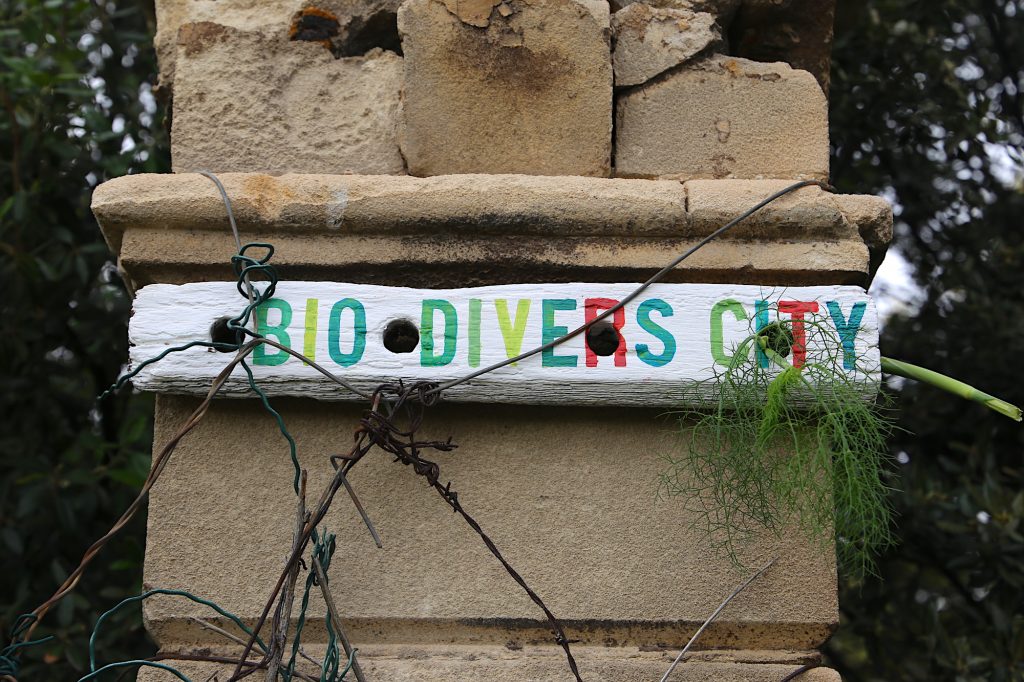
Nooks & Crannies.
But this is not a brownfield site – it is the remains of villa gardens of a large estate – Miramar, on the gentle slope towards the sea, a place to admire the Bay of Marseille and watch the sun set. In the nooks and crannies, seeds blown there by the sea winds or carried on the tangled fur of an animal, begin their germination, drawing up life from the humid soil. Each day, each hour the grasses and the wild flowers, reach toward the light, growing a little more willowy and coarse; building a structure capable of withstanding the wind, gently rocking in the breeze or ready to bend almost horizontal in the storm-laden air. Between the base of the stem, where the rye grass competes with wild barley and wild oats other seeds begin their ascent, breaking through the friable soil.
So, it is in the variety of habitat, in the odd mosaic of garden-nature that Miramar continues to evolve. And as any urban ecologist knows the best solution to healthy bio-diversity is to leave the soil and allow natural processes of re-colonisation and re-wilding to occur on brownfield sites or in the in-between of semi-abandoned plots. As Patrick X – Marseille’s ‘Director of Bio-Diversity’ points out the hardest thing is to persuade the urban dweller and the authorities just to leave things, stop chopping, and pollarding and tidying. In London, complaints on streets by house owners, because their cars get covered in falling leaves, leads to the annual culling of thousands of trees. Luckily, on other streets locals campaign for more tree planting.

The constellation of grasses/Un constellation des germes:
On the savannah, a blackening inferno rages – certain seeds of pyrophytic plants will wait patiently for years for the wind and the storms to combine and rage into a combustible fire. One of these is the American Giant sequoia, along with the native Mediterranean cork oak. When the land at Miramar was transferred to new ownership two majestic sequoia that stood on the site were hurriedly felled. Something ironic then, as the contractors tasked with clearer the site in April 2021 claimed it was for fire precaution reasons. The giant stump of the sequoia remains as a reminder of this original vandalism. The sequoia is also named after a Cherokee linguist (Sequoiadendron giganteum) and provides a cultural link to native American understandings of the human’s place among the greater universe of creatures and the living breathing planet; this greater constellation of being and the balance of forces maintained within a natural healthy eco-system.
So, this constellation of fire – this fiery reproduction – is a composition that only nature can orchestrate. In the constellation of the common grasses, this complex composition of species has been reduced to a handful of races or genetic lineages. The reserve of large corporate seed ‘manufacturers’. This is entirely down to our desire to control nature and to profit from its bounty. Again, we see this misguided desire in our delusional attempts to eradicate fire – in futile attempts to save property and the rights of the owner. But who really owns the land, who really controls the composition of soil – the strange unexpected consequences of composting and cross-fertilisations. In this year when nature’s fire seemed to rage across the civilised world with a certain savagery perhaps we should again respect more the untameable, and unpredictable. And let the grasses grow again in all their beauty – across the windblown ocean prairies, to unleash the natural process of fiery regeneration.
For another pre-history of fire and fires civilising power see: (see David Graeber’s article How to change the course of Human History: at least for the part that’s already happened – here )
The discovery of fire by humans: a long and convoluted process by J. A. J. Gowlett Published:05 June 2016 in https://royalsocietypublishing.org/doi/10.1098/rstb.2015.0164
in ‘The interaction of fire and mankind’ organized and edited by Andrew C. Scott, William G. Chaloner, Claire M. Belcher and Christopher I. Roos (Royal Society Publishing 05 June 2016 Volume 371Issue 1696
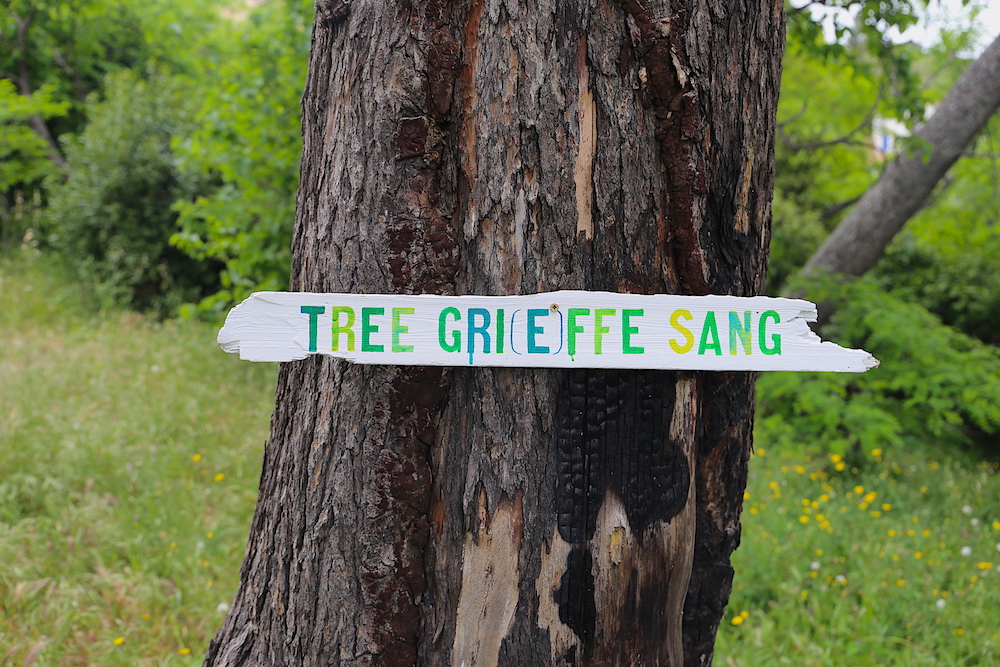
*Giant sequoias are in many ways adapted to forest fires. Their bark is unusually fire resistant, and their cones will normally open immediately after a fire.The giant sequoias are having difficulty reproducing in their original habitat (and very rarely reproduce in cultivation) due to the seeds only being able to grow successfully in full sun and in mineral-rich soils, free from competing vegetation. Although the seeds can germinate in moist needle humus in the spring, these seedlings will die as the duff dries in the summer. They therefore require periodic wildfire to clear competing vegetation and soil humus before successful regeneration can occur. Without fire, shade-loving species will crowd out young sequoia seedlings, and sequoia seeds will not germinate. When fully grown, these trees typically require large amounts of water and are therefore often concentrated near streams. (Wikipedia entry, accessed 30 May 2021)
“pour pick et nique”
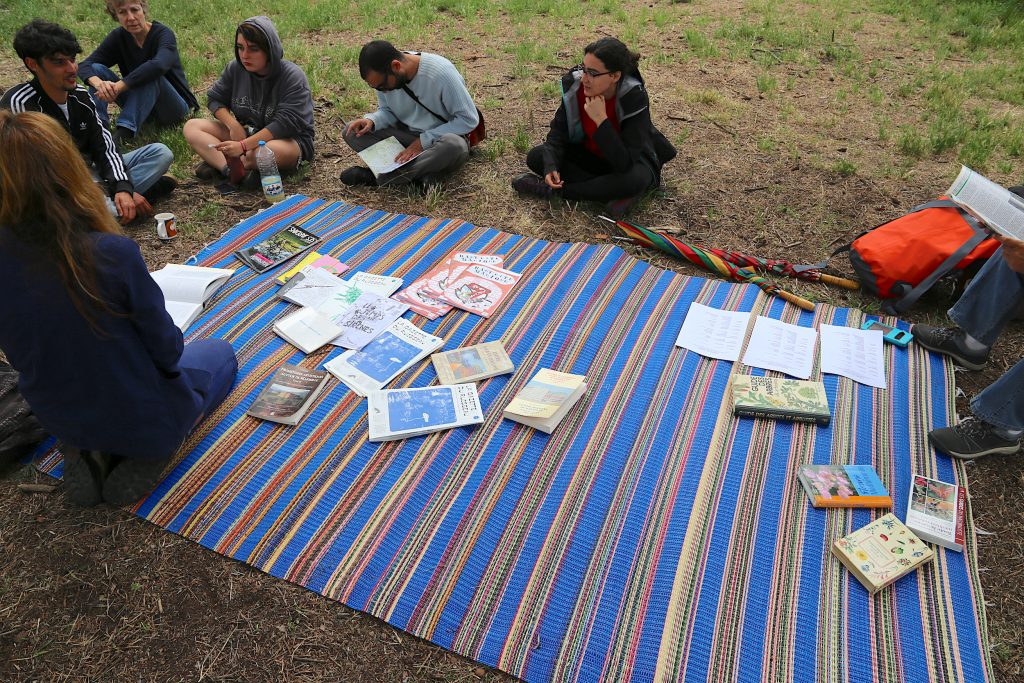
The fertility of the soil is not doubted. When the rains come the seeds will swell, fruits and flowers fill with sweet sap and renewed fertilisation begin. Here, while we sit pic-nicing, discoursing with human language, the ground trembles with intercourse and the mingling of species. How many specimens, how many varieties, how many plants and animals shelter in this small mosaic of interlocking environments?
On the flat terrace, mature trees pierce the turquoise sky, behind where a pond was, grasses two metres high are swaying in the breeze, below us and running off the hill from where the Autoroute rushes passed above us, a small stream, damp and humid allows other plants to thrive. And in triangle left by the edge of the Railway embankment remnants perhaps of an orchard, the villa’s potager. It is a rare and welcome place for a new kind of pic–niquing, between and among the many inter/species.
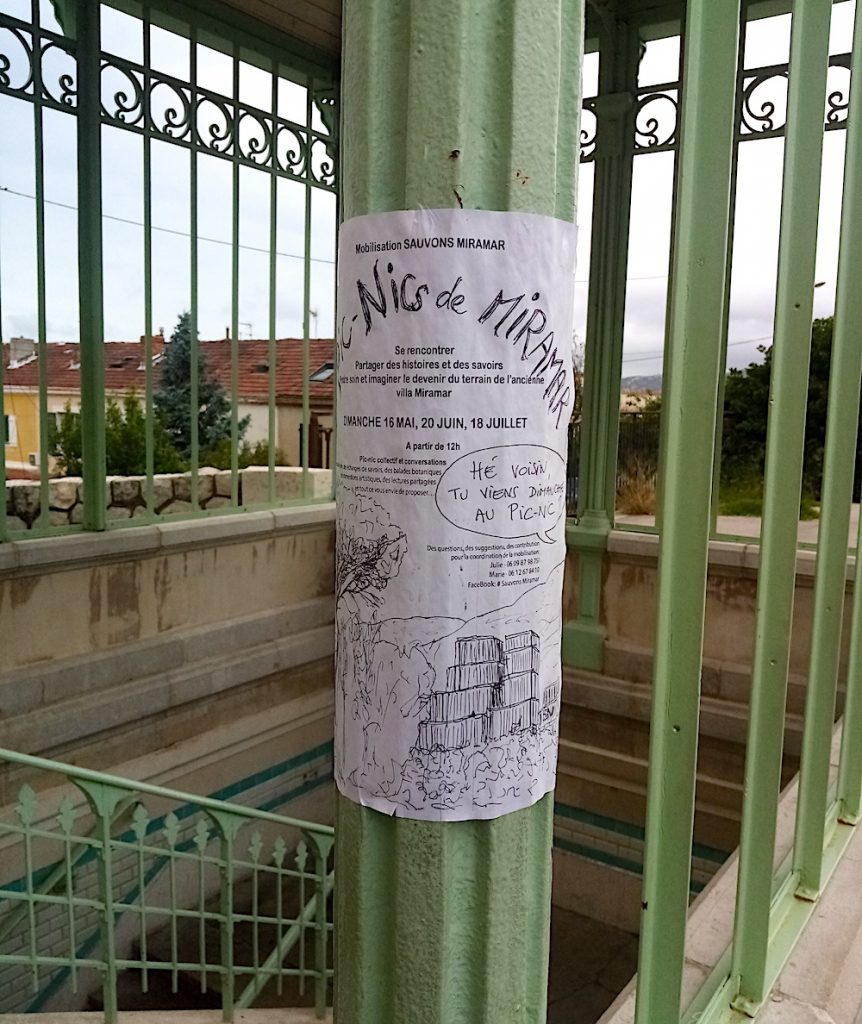
Mirror Miramar:
On the ground, Mirabelle
There is a singing in the trees
‘O mirror-moi, sweet sherry plum
U, Bois – sonne fool, blossom on
I, The avenir’s brighten in
A future, on the ground (May 2021)
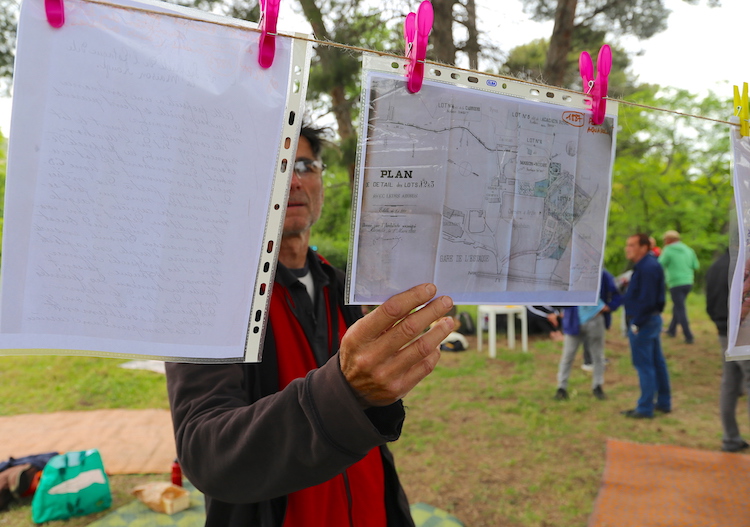
A plan of Miramar Villa site – dug out from the archives and represented on the ground/s at first pic-nic gathering 16/5/2021
“Human beings are terrestrial creatures; they live on the ground… But what is the ground?” (122) from Footprints through the weather-world: walking, breathing, knowing – Tim Ingold in The Journal of the Royal Anthropological Institute (Vol. 16, Making knowledge (2010), pp. S121-S139 -19 pages)
The Mirror Miramar – the gaze of a city – how it wishes to see itself, to view and be viewed as it looks out to the sea. Perhaps the tide in politics and social relationships is beginning to turn away from one of violent struggle with the natural, and aligning with other forms of the social suggested by our mimicking in nature; a breaking of the boundaries, with the artificial framing that places some things inside while excluding the rest, outside. Perhaps Paul Cezanne’s paintings finally represent a premonition of human sight dissolving into a shimmering fluid nature. Unable to capture the real with an all-seeing verity his experiments with paint led him to an endless struggle with form – certain and uncertain marks building a fluid and shimmering vision. Tentative and measured, sometime wild and unkempt with a touch of the classical – mixed, Hellenistic, with a shifting identity made from this hospitality on the ground, the welcoming of people. Perhaps time now then, for Marseille to represent itself in new ways – returning the concrete to the rock and soil as it washes down from the plateaus towards the mirror sea… another knowledge – becoming knowledgeable and in embodied knowledge.
The Miracle – A mira/clé pour Mirror-moi
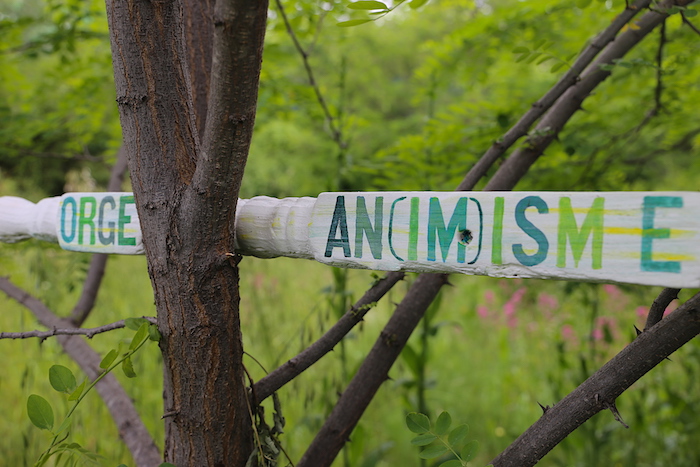
“There is a singing in the trees/‘O mirror-moi, sweet cherry plum”
In January I start filming a short super 8 film – a gift – for the first time in 20 years I am using a movie camera. It is very simple, very robust, it seems to have a life of it on, as the reel spools through the shutter, I hear the film developing, replayed with another light, bleached, episodic with a crude dancing light. Somehow, I return hypnotically to Miramar as the sun descends steeply in the winter – trying to capture the dry grass, the rustle of thistles and teasles, of dried wilderness in all its shimmering depth. The experiment with film and light mirrors for me the miracle of Miramar. A simple tool, almost redundant, repurposed with another aesthetic. The gardens at Miramar were once grandly laid out and were donated as a gift to Marseille – as a place for healing. Little of the Villa remains except the trees planted or cultivated when the land was part of the garden complex. But now, again they are magnificent, irreplaceable sentinels. Like a short 8 mm film, that seems totally irrelevant to the modern world – re-living as a kind of wild experimental beauty dependent on the light, the sun. The miracle now will be that these trees remain as the foundation of a repurposed and resurrected art – a kind of wild gardening that takes care of its terrain and loves what the soil, rains and sun offers up to all who dwell-in North Marseille.
On Sunday Second of May the community of North Marseille, led by Hotel du Nord, created a walk – a Balade Harmonique to join the green spaces of the district. Because of the events leading up to the walk the route was changed so that the community could make its way through L’Estaque and slowly arrive at Miramar. This walk will undoubtedly become the foundational fete for Sauvons Miramar. It has already created its own myths, its own small rituals and gifts. Not least in the vegetable garden created by Hammid with the collaboration of his neighbours. And now to add – to add to this Harmonique of gatherings and pic-nics – totems, songs, researches, feasts, the conversation of grasses…

In London, on the evening of 12th June 2021, InspiralLondon will lead a walk from Dartford Marshes along the southern bank of the Thames towards Gravesend. Passing through Swanscombe Marsh, part of former gravel pits and its fringe of industry (concrete manufacture and other aggregates). This unique site has been earmarked for development to become Europe’s largest Theme Park – the developers claim they will make the marshland more bio-diverse! But local groups and national organisation, now including Nature England have been fighting to save the integrity of the marsh and leave it as untouched as possible (https://www.buglife.org.uk/campaigns/save-swanscombe-marshes/ & https://www.theguardian.com/environment/2021/mar/11/natural-england-gives-proposed-london-resort-site-protected-status). In March, the site was given SSSI status (Site of Special Scientific Interest – in UK Law this is the nearest thing to protection from development). Unfortunately, the site is not secured as a nature reserve despite the fact of its unique bio-diversity and its cultural value – as one of the first sites of prehistoric human activity – here the famous Swanscombe man was found in 1935-1955 during quarrying. It is the oldest human skull discovered on the British Isles – and should merit some care. The skeleton was presumed to be a male dated 300,000 plus – but is probably the skull of an early Neanderthal woman – perhaps 400,000 old. The site is also famous for its pre-Neanderthal finds – fossilized animal bones (Mammoths etc.) and fine handaxes dated to the Hoxnian Interglacial c. 400,000 year old. The site itself was 8 metres below the current level and on the former shoreline of the Thames, hundreds of metres from its current course. (Swanscombe Man Wikipedia Link – May 2021)
The mixing of genetic diversity – of natural cross-breeding and germination, afforded by all the unremarked activity of invertebrates, busily pollinating. The miracle of the rare jumping spider found only in Swanscombe must be emblematic. To save this biodiversity and sustain ourselves we must learn to keep jumping – jumping from generation to generation. The fire of bio-diversity and difference smoulders slowly beneath the leaf mold. The key to the miracle at Miramar will be the slow growth of a community dedicated to the care of all the flora and fauna and conscious of the social relations that sustain us, in gathering with the other.
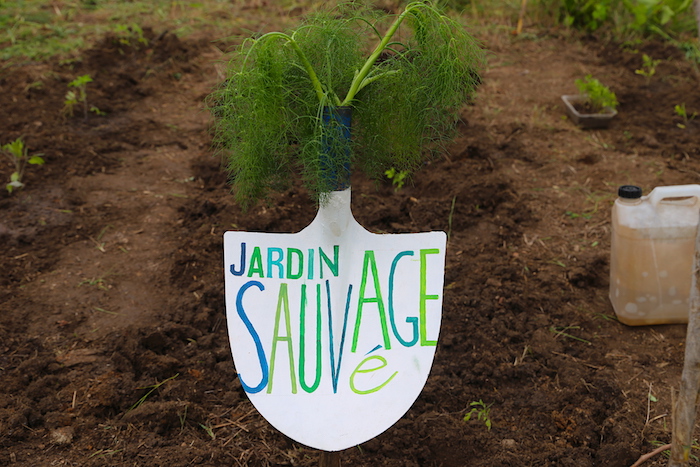
Malgre Tout – The rain will come:
May 1 2021 – I stand on the edge of Miramar stream, listening to the damp rustle of trees. My microphone held out into the twilight. I am contributing this sound to the Reveil 8 programme (soundcamp’s annual livestreaming of Dawn Chorus across the globe for 24 hours +1in partnership with locus sonus). Part of Inspirallondon’s curated livestream mix – Hydracity Streamings – created from four sites, tracking aspects of the watery commons hidden beneath the dusk chorus. The live soundscape come from four urban or semi-urban sites, relaying differences in ambiance flowing through early twilight from North Marseille to Thamesmead (East London), onto North Peckham (South London) and across to a strip of ancient woodlands, meandering by a stream through suburban Reading (West of London).
From around 8pm (7pm GMT) I had walked from the hills of St Henri toward L’Estaque to rendezvous with members of the Hotel du Nord, the site of former Villa Miramar. A period of heavy rainfall had just lifted, creating sheets of water that ran off the tarmac in dark slippery strokes. The city of Marseille, suddenly waterlogged, dripped and oozed water from places that ordinarily are bone dry. It was a sign of renewal, and new beginnings, that water brings, refreshing the earth and giving new life. Apt then, for beginning this livestream audio event, by exploring something of the unkempt and undervalued beauty of this hidden paradise – a remnant of villa park – trapped between the railway, a new road for a port container storage facility and a steep escarpment, on which a haphazard community of houses and factories sit. Perhaps because of the recent rains the birds were subdued but the site presented its rare inestimable beauty in the odours, scents and rustling of an overflowing water that made the ground spongey, almost friable beneath our feet.
Briefly Inspiral met with Julie Demuer (representing the Hotel du Nord), by the site of two felled pine tree. We were able to share then something of this fragile but tenacious beauty, incarnated in this unique plot of land. Only the day before, and one week since the trees on the site were scheduled to be chopped down by the new owner, the community of L’Estaque (Sauvons Miramar) had definitive news that the site had been protected*. With its unique biodiversity, its cultural, heritage and social amenity value, one small but significant parcel of watery commons has been saved from imminent concretisation and development. Charlie Fox May 2021 (images: counterproductions & Word-Objets in collaboration with Miramar Community)
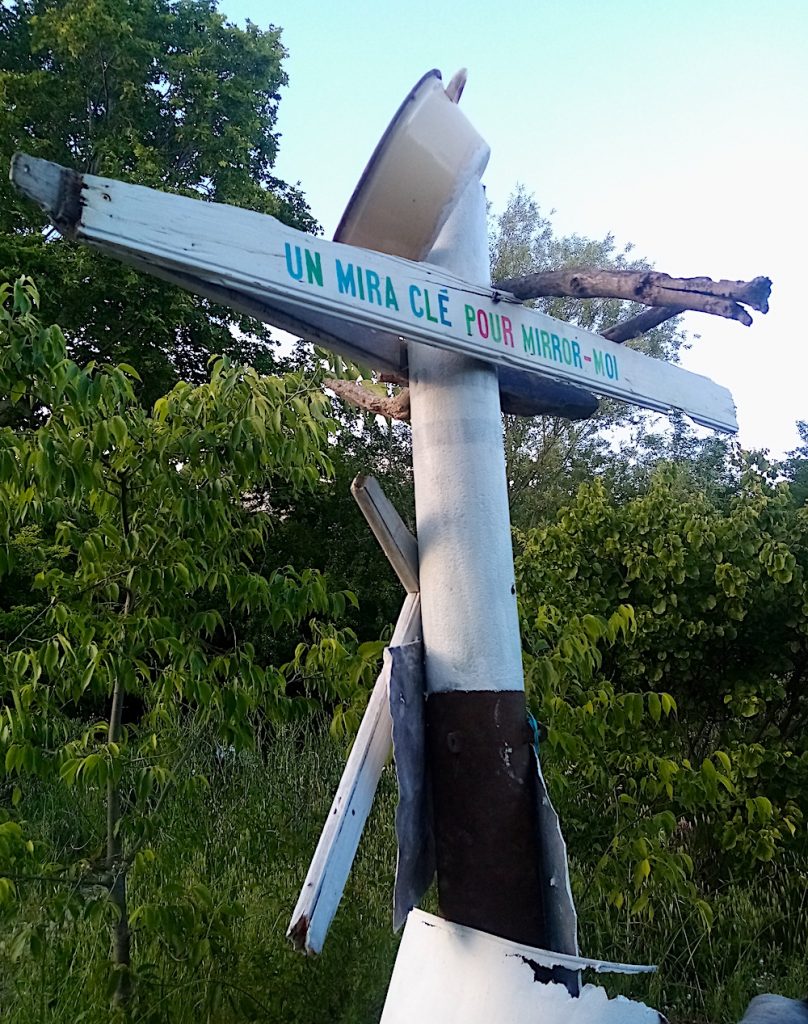
With special thanks to Julie Demuer, Mathilde Haegel, Alan and, Jean & Hamid of Miramar
A Sauvons Miramar:
Merci à tout le monde,
Pour toute votre hospitalité et le générosité du terroir (la terre de Miramar). Je me sens honoré de contribuer au récits de ce lieu unique et rare. Pour fêter ça, J’ai écrit un texte avec des images en anglais pour InspiralLondon HERE. Partager…. Chaleureusement

